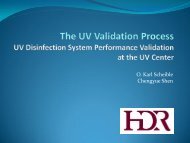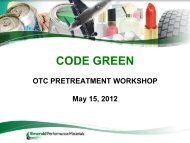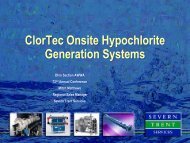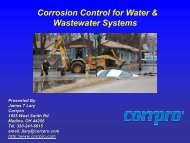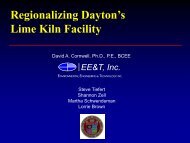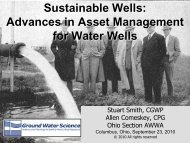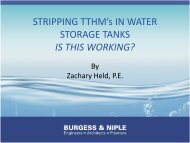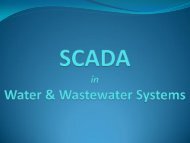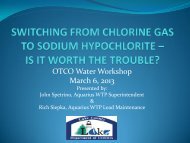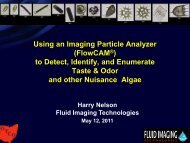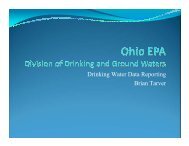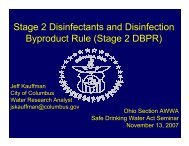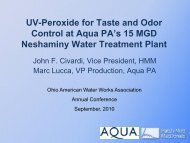Chlorine Decay, Water Age, and THMs - OH MY - Ohiowater.org
Chlorine Decay, Water Age, and THMs - OH MY - Ohiowater.org
Chlorine Decay, Water Age, and THMs - OH MY - Ohiowater.org
Create successful ePaper yourself
Turn your PDF publications into a flip-book with our unique Google optimized e-Paper software.
<strong>Chlorine</strong> <strong>Decay</strong>, <strong>Water</strong> <strong>Age</strong>, <strong>and</strong> <strong>THMs</strong> – <strong>OH</strong> <strong>MY</strong>Residual <strong>Decay</strong> Models• Residual decay follows first order reactionCtCoekt• C t = concentration at time t• C o = initial concentration• k = residual decay coefficient• t = decay time in days• Calculate decay coefficients (k) using reaction equation• Excel graphing function works well• <strong>Decay</strong> models developed using identified coefficients forfree chlorine <strong>and</strong> monochloramine4
<strong>Chlorine</strong> <strong>Decay</strong>, <strong>Water</strong> <strong>Age</strong>, <strong>and</strong> <strong>THMs</strong> – <strong>OH</strong> <strong>MY</strong>Residual <strong>Decay</strong> Models• First order reactionCtCoekt• Calculate decay coefficient (k) using water age from zero days to xdays• Two day intervals• Can use shorter or longer intervals as needed• k values appear to be site specific• Temperature dependence of k - 2 fold change for each 10 o C changein temperature (adjust k accordingly)5
<strong>Chlorine</strong> <strong>Decay</strong>, <strong>Water</strong> <strong>Age</strong>, <strong>and</strong> <strong>THMs</strong> – <strong>OH</strong> <strong>MY</strong>Residual <strong>Decay</strong> Models• First order reactionCtCoekt• Calculate decay using average to maximum residual concentrations• May need to spike sample to a known concentration• Model data tabulated into spreadsheet• Graphical illustrations of model data predictions• Free chlorine decay much faster than monochloramine decay• <strong>Decay</strong> occurs due to <strong>org</strong>anics, ammonia, iron, manganese6
<strong>Chlorine</strong> <strong>Decay</strong>, <strong>Water</strong> <strong>Age</strong>, <strong>and</strong> <strong>THMs</strong> – <strong>OH</strong> <strong>MY</strong>Laboratory Data Collection• Plant tap samples analyzed <strong>and</strong> held at room temperature• Residuals analyzed initially (day zero), then at simulated water agesof 1 day, 3 days, 5 days, etc.• Free chlorine• Monochloramine• Residual decay determined from lab data• Based on current plant operations <strong>and</strong> water quality• Calculations <strong>and</strong> graphical illustrations• Determination of decay coefficient (k)• Free chlorine• Monochloramine7
<strong>Chlorine</strong> <strong>Decay</strong>, <strong>Water</strong> <strong>Age</strong>, <strong>and</strong> <strong>THMs</strong> – <strong>OH</strong> <strong>MY</strong>Laboratory Data CollectionAverage Finished <strong>Water</strong> Quality - Plant AParameterConcentration<strong>Water</strong> pH, s.u. 8.3Alkalinity, mg/L as CaCO 3 80TOC, mg/L 4.1UV absorbance, cm -1 0.058SUVA, L/mg-m 1.41THMFP, µg/L 252<strong>Chlorine</strong> dem<strong>and</strong>, mg/L 2.148
<strong>Chlorine</strong> <strong>Decay</strong>, <strong>Water</strong> <strong>Age</strong>, <strong>and</strong> <strong>THMs</strong> – <strong>OH</strong> <strong>MY</strong>Laboratory Data CollectionFree <strong>Chlorine</strong><strong>Decay</strong> CurvefromExperimentalData9
<strong>Chlorine</strong> <strong>Decay</strong>, <strong>Water</strong> <strong>Age</strong>, <strong>and</strong> <strong>THMs</strong> – <strong>OH</strong> <strong>MY</strong>Laboratory Data CollectionMonochloramine<strong>Decay</strong> CurvefromExperimentalData11
<strong>Chlorine</strong> <strong>Decay</strong>, <strong>Water</strong> <strong>Age</strong>, <strong>and</strong> <strong>THMs</strong> – <strong>OH</strong> <strong>MY</strong>Laboratory Data CollectionMonochloramine<strong>Decay</strong> CurvefromExperimentalData -CorrelatingTemperatureDependence12
<strong>Chlorine</strong> <strong>Decay</strong>, <strong>Water</strong> <strong>Age</strong>, <strong>and</strong> <strong>THMs</strong> – <strong>OH</strong> <strong>MY</strong>Laboratory Data CollectionAverage Finished <strong>Water</strong> Quality - Plant BParameterConcentration<strong>Water</strong> pH, s.u. 8.5Alkalinity, mg/L as CaCO 3 56TOC, mg/L 1.2UV absorbance, cm -1 0.024SUVA, L/mg-m 1.90THMFP, µg/L 53<strong>Chlorine</strong> dem<strong>and</strong>, mg/L 1.4213
<strong>Chlorine</strong> <strong>Decay</strong>, <strong>Water</strong> <strong>Age</strong>, <strong>and</strong> <strong>THMs</strong> – <strong>OH</strong> <strong>MY</strong>Laboratory Data CollectionFree <strong>Chlorine</strong><strong>Decay</strong> CurvefromExperimentalData14
<strong>Chlorine</strong> <strong>Decay</strong>, <strong>Water</strong> <strong>Age</strong>, <strong>and</strong> <strong>THMs</strong> – <strong>OH</strong> <strong>MY</strong>Laboratory Data CollectionFree <strong>Chlorine</strong><strong>Decay</strong> CurvefromExperimentalData -CorrelatingTemperatureDependence15
<strong>Chlorine</strong> <strong>Decay</strong>, <strong>Water</strong> <strong>Age</strong>, <strong>and</strong> <strong>THMs</strong> – <strong>OH</strong> <strong>MY</strong>Model Data versus System Data - Plant AFree <strong>Chlorine</strong>ResidualsComputer ModelPredictionsActual SystemMonitoring2 day water age, mg/L 1.01 0.964 day water age, mg/L 0.56 0.536 day water age, mg/L 0.32 0.308 day water age, mg/L 0.20 0.2095.6% accuracyBased on average plant tap free chlorine residual 1.8 mg/L16
<strong>Chlorine</strong> <strong>Decay</strong>, <strong>Water</strong> <strong>Age</strong>, <strong>and</strong> <strong>THMs</strong> – <strong>OH</strong> <strong>MY</strong>Hydraulic Modeling17
<strong>Chlorine</strong> <strong>Decay</strong>, <strong>Water</strong> <strong>Age</strong>, <strong>and</strong> <strong>THMs</strong> – <strong>OH</strong> <strong>MY</strong>Hydraulic Modeling - <strong>Water</strong> <strong>Age</strong>• Hydraulic modeling based on system operations• Computerized map of distribution system• Pipe sizes <strong>and</strong> lengths• 6-inch <strong>and</strong> greater diameters typical• 4-inch <strong>and</strong> greater for small systems• Flow from plant through system• Software predicts flow patterns <strong>and</strong> water age• Some software can predict water quality changes• <strong>Water</strong> age map color coded corresponding to predictions• Low water age near treatment plant• High water age at extremities• Related to residual decay <strong>and</strong> DBP formation18
<strong>Chlorine</strong> <strong>Decay</strong>, <strong>Water</strong> <strong>Age</strong>, <strong>and</strong> <strong>THMs</strong> – <strong>OH</strong> <strong>MY</strong>Hydraulic Modeling <strong>Water</strong> <strong>Age</strong> - Plant A4 days8 days4 days2 days2 days8 days2 daysWTP4 days6 days2 days4 days6 days4 days19
<strong>Chlorine</strong> <strong>Decay</strong>, <strong>Water</strong> <strong>Age</strong>, <strong>and</strong> <strong>THMs</strong> – <strong>OH</strong> <strong>MY</strong>Hydraulic Modeling <strong>Water</strong> <strong>Age</strong> - Plant B8-10days6-8days6-8days10days20
<strong>Chlorine</strong> <strong>Decay</strong>, <strong>Water</strong> <strong>Age</strong>, <strong>and</strong> <strong>THMs</strong> – <strong>OH</strong> <strong>MY</strong>Comparisons of <strong>Decay</strong> <strong>and</strong> <strong>Water</strong> <strong>Age</strong>• Distribution chlorine monitoring used to compare residualdecay <strong>and</strong> hydraulic models• Residual maintenance effective in much of the system• Maintenance difficulties at the system extremities• <strong>Decay</strong> data compares closely to predicted water age• Can be used for water age predictions• Believed to be accurate for establishing operating parameters basedon disinfection practices21
<strong>Chlorine</strong> <strong>Decay</strong>, <strong>Water</strong> <strong>Age</strong>, <strong>and</strong> <strong>THMs</strong> – <strong>OH</strong> <strong>MY</strong><strong>Decay</strong> vs. <strong>Water</strong> <strong>Age</strong> - Plant A4 days8.5 days8 days4 days3.5 days4.5 days2 days2 days8 days2 days2 days2 days5.5 daysWTP7 days4 days6 days3.5 days2 days4 days6 days4 days22
<strong>Chlorine</strong> <strong>Decay</strong>, <strong>Water</strong> <strong>Age</strong>, <strong>and</strong> <strong>THMs</strong> – <strong>OH</strong> <strong>MY</strong><strong>Decay</strong> vs. <strong>Water</strong> <strong>Age</strong> - Plant B8-10days6-8days11days7 days7 days6-8days3.5days10days23
<strong>Chlorine</strong> <strong>Decay</strong>, <strong>Water</strong> <strong>Age</strong>, <strong>and</strong> <strong>THMs</strong> – <strong>OH</strong> <strong>MY</strong>THM Formation24
<strong>Chlorine</strong> <strong>Decay</strong>, <strong>Water</strong> <strong>Age</strong>, <strong>and</strong> <strong>THMs</strong> – <strong>OH</strong> <strong>MY</strong>THM Formation Reaction0.44 0.409 0.2651.060.7150. 0358UV* TOC * Cl * RXN * TEMP * pH 2.6 *( Br 1TTHM, moles / L 0.00309*254 2)UV254 UVabsorbanceat254nanometers,cm1TOC Total<strong>org</strong>aniccarbon,mg / LCl2 <strong>Chlorine</strong>dosage,mg / LRXN Coefficien trelatedtowaterageTEMP <strong>Water</strong>temperature,oCpH <strong>Water</strong> pH,s.u.Br Bromide,mg / LFormation <strong>and</strong> Control of Disinfection Byproducts in Drinking <strong>Water</strong>AWWA 199925
<strong>Chlorine</strong> <strong>Decay</strong>, <strong>Water</strong> <strong>Age</strong>, <strong>and</strong> <strong>THMs</strong> – <strong>OH</strong> <strong>MY</strong>THM Formation Reaction• Strong formation dependence• <strong>Water</strong> temperature• <strong>Water</strong> pH• Organic content• <strong>Chlorine</strong> dosage• Weaker formation dependence• <strong>Water</strong> age or residence time• Bromide concentrationChloroform26
<strong>Chlorine</strong> <strong>Decay</strong>, <strong>Water</strong> <strong>Age</strong>, <strong>and</strong> <strong>THMs</strong> – <strong>OH</strong> <strong>MY</strong>THM Formation Reaction• Parameters Under Operational Control• <strong>Water</strong> pH• Organic content• <strong>Chlorine</strong> dosage• <strong>Water</strong> age (storage <strong>and</strong> system residence)• Cannot be controlled• <strong>Water</strong> temperature• Bromide concentration27
<strong>Chlorine</strong> <strong>Decay</strong>, <strong>Water</strong> <strong>Age</strong>, <strong>and</strong> <strong>THMs</strong> – <strong>OH</strong> <strong>MY</strong>Organic Contaminants in <strong>Water</strong>Aromatic CarbonMoleculesAromatic Carbon Ring Structure• Contain numerousdouble carbonbonds in a ringstructure• Double bonds <strong>and</strong>aromatic carbonsmeasured by UVA• Influence SUVAmake-up• Double bonds easilybroken – formdisinfectionbyproducts reactingwith halogens28
SUVA (L/mg-m)<strong>Chlorine</strong> <strong>Decay</strong>, <strong>Water</strong> <strong>Age</strong>, <strong>and</strong> <strong>THMs</strong> – <strong>OH</strong> <strong>MY</strong>Organic Contaminants in <strong>Water</strong>8.07.57.06.56.05.55.04.54.03.53.02.52.01.51.00.50.0Transphilicacids (TPHA)Fulvic Acids(FA)Harder toRemove0 10 20 30 40% Aromatic CarbonHumic Acids(HA)Easier toRemove29
<strong>Chlorine</strong> <strong>Decay</strong>, <strong>Water</strong> <strong>Age</strong>, <strong>and</strong> <strong>THMs</strong> – <strong>OH</strong> <strong>MY</strong>Impacts from Disinfection Treatments<strong>Chlorine</strong>• <strong>Chlorine</strong> dosage affects THM formation• Higher dosages lead to higher <strong>THMs</strong>• Increased dosage favors HAA5 formation over THM formation(dichloro- <strong>and</strong> trichloro- species, pH dependency)• Can result in NOM fractioning to TPHA <strong>and</strong> HPI• Can increase AOC byproductsHPC Bacteria Plate30
<strong>Chlorine</strong> <strong>Decay</strong>, <strong>Water</strong> <strong>Age</strong>, <strong>and</strong> <strong>THMs</strong> – <strong>OH</strong> <strong>MY</strong>Temperature/pH Effects• Formation reaction changes 2 fold each 10 o C change• Lower temp slows reaction rate• Higher temp speeds reaction rate• Summer conditions significantly increase THM levels• Affects NOM concentrations <strong>and</strong> precursor material• Lower temp reduces <strong>org</strong>anic decay <strong>and</strong> NOM in source water• Higher temp increases NOM formation from <strong>org</strong>anic decay31
<strong>Chlorine</strong> <strong>Decay</strong>, <strong>Water</strong> <strong>Age</strong>, <strong>and</strong> <strong>THMs</strong> – <strong>OH</strong> <strong>MY</strong>Temperature/pH Effects• pH dependence on THM formation• High pH favors THM formation over HAA5 formation• High pH increases THM formation reaction rate• High pH increases chloroform concentrations• High pH reduces HAA5 formation• Low pH opposite of above32
<strong>Chlorine</strong> <strong>Decay</strong>, <strong>Water</strong> <strong>Age</strong>, <strong>and</strong> <strong>THMs</strong> – <strong>OH</strong> <strong>MY</strong>Bromide Effects on THM Reactions• Form DBPs 2 times faster than chlorine• Shifts from chlorinated to brominated species• Halogen substitution reactions like chlorine (Br - ion)• Attacks more NOM sites than chlorine• 50% bromide reacts to form <strong>THMs</strong>, where only 10% chlorine reacts toform <strong>THMs</strong>• Impact on THM concentration dependent on NOM concentration• Low NOM reduces bromide reactionBromoform33
<strong>Chlorine</strong> <strong>Decay</strong>, <strong>Water</strong> <strong>Age</strong>, <strong>and</strong> <strong>THMs</strong> – <strong>OH</strong> <strong>MY</strong><strong>Water</strong> <strong>Age</strong>/Residence Time Impacts• Single most important factor in THM formation• 20% to 50% <strong>THMs</strong> form within treatment plant,remainder form in distribution system• <strong>THMs</strong> form fast in 1 st 48 hours, then reaction slowsexponentially• 70% to 95% HAA5s form within treatment plant• Long residence time increases <strong>THMs</strong> in storage tanks<strong>and</strong> piping• Can result in biodegradation of HAA5• Reduction in water age reduces <strong>THMs</strong> (flushing,looping mains, tank mixing, etc.)34
<strong>Chlorine</strong> <strong>Decay</strong>, <strong>Water</strong> <strong>Age</strong>, <strong>and</strong> <strong>THMs</strong> – <strong>OH</strong> <strong>MY</strong>THM Treatment Control Methods• Oxidative conditioning• Strong oxidant application severs C=C bondsmaking TOC removal more effective• Avoid changing hydrophobic matter intohydrophilic matter• Coagulant precipitation <strong>and</strong> adsorption• Iron salts typically more effective than aluminumsalts• Dosage important to remove TOC• Alkalinity more important than pH for TOCremoval35
TOC Concentration, mg/L<strong>Chlorine</strong> <strong>Decay</strong>, <strong>Water</strong> <strong>Age</strong>, <strong>and</strong> <strong>THMs</strong> – <strong>OH</strong> <strong>MY</strong>THM Treatment Control Methods• Enhanced softening• Mg(<strong>OH</strong>) 2 acts as coagulant adsorbing TOC• Additional 10% to 30% TOC removal possible• Avoid saponification with high pH5.505.255.004.754.504.254.003.75High pHleads to poorremovals3.503.253.002.752.509.50 9.75 10.00 10.25 10.50 10.75 11.00 11.25 11.50 11.75 12.00<strong>Water</strong> pH, s.u.36
<strong>Chlorine</strong> <strong>Decay</strong>, <strong>Water</strong> <strong>Age</strong>, <strong>and</strong> <strong>THMs</strong> – <strong>OH</strong> <strong>MY</strong>THM Treatment Control Methods• Biological Filtration• Sufficient oxidation to increase BDOC <strong>and</strong> AOC• Ozone most common, but other strong oxidants can beused• Conventional treatment can result in biological TOCreduction in filters• 6% to 14% observed in full-scale operations• GAC substrate used to grow TOC reducing bacteria37
<strong>Chlorine</strong> <strong>Decay</strong>, <strong>Water</strong> <strong>Age</strong>, <strong>and</strong> <strong>THMs</strong> – <strong>OH</strong> <strong>MY</strong>THM Treatment Control Methods• GAC Contactors• EBCT most important parameter• 20 minutes most effective• 10 minutes effective with more frequent GACreplacement• TOC breakthrough dependent on make-up of NOM<strong>and</strong> concentration applied• 30 days to 350 days provided in many WTPs38
<strong>Chlorine</strong> <strong>Decay</strong>, <strong>Water</strong> <strong>Age</strong>, <strong>and</strong> <strong>THMs</strong> – <strong>OH</strong> <strong>MY</strong>THM Treatment Control Methods• Anion Exchange Treatment• Strong base anion (SBA) resins remove TOC• Several manufacturers <strong>and</strong> exchange capacitiesavailable• Macroporous resins have longer life• Gel type resins capture smaller molecularweight NOM• Relatively high bed volume throughputbetween regenerations• Typical TOC removal 55% to 95%• TOC breakthrough <strong>and</strong> pH increase generallysignal regenerationAnion ExchangeReactors39
<strong>Chlorine</strong> <strong>Decay</strong>, <strong>Water</strong> <strong>Age</strong>, <strong>and</strong> <strong>THMs</strong> – <strong>OH</strong> <strong>MY</strong>THM Treatment Control Methods• Membranes• NF or RO membranes provide TOCremoval• Dependent on MWCO (
<strong>Chlorine</strong> <strong>Decay</strong>, <strong>Water</strong> <strong>Age</strong>, <strong>and</strong> <strong>THMs</strong> – <strong>OH</strong> <strong>MY</strong>THM Treatment Control Methods• Tank Aeration/Mixing• Stripping of volatile THM compounds withaeration in storage tanks• Chloroform most common form removed, butcan reduce other THM species• Ventilation of air space above water important• Mixing helps reduce stagnant water zones• Improved residual maintenance• Air-to-water ratio important to produceTHM stripping without depleting chlorineresidual41
<strong>Chlorine</strong> <strong>Decay</strong>, <strong>Water</strong> <strong>Age</strong>, <strong>and</strong> <strong>THMs</strong> – <strong>OH</strong> <strong>MY</strong>Tank Turnover vs. <strong>Water</strong> <strong>Age</strong>• Tank Turnover• Fluctuating water levels daily• 15% to 60% turnover is common• Theoretically reduces water age in storage• Actually does not reduce stagnant zones orresidual decay• Stagnant zone rides up <strong>and</strong> down with waterlevel• System flushing likely best practice toremove stagnant water from the system• From plant outwards to the system extremities• Durations determined by residuals producedafter flushing42
<strong>Chlorine</strong> <strong>Decay</strong>, <strong>Water</strong> <strong>Age</strong>, <strong>and</strong> <strong>THMs</strong> – <strong>OH</strong> <strong>MY</strong>Summary• Computer models can be useful for establishing operatingtargets• Hydraulic modeling can be useful for predicting water age• Residual decay modeling can predict water age close to hydraulicmodels <strong>and</strong> can predict residuals in the system• THM formation is a function of many parameters thatcannot be totally controlled• Reducing <strong>org</strong>anics, managing pH, <strong>and</strong> controlling water age are bestpractices for lowering THM formation– Reduces residual decay that results in higher <strong>THMs</strong>– Reducing water age by flushing <strong>and</strong> storage levels reduces THM formation• Tank mixing <strong>and</strong> aeration helps remove <strong>THMs</strong> that form in the system43
<strong>Chlorine</strong> <strong>Decay</strong>, <strong>Water</strong> <strong>Age</strong>, <strong>and</strong> <strong>THMs</strong> – <strong>OH</strong> <strong>MY</strong>Marvin Gnagymcg7@bex.net419.450.293144



